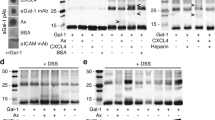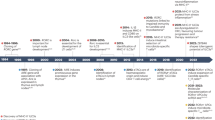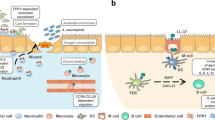Key Points
-
Dendritic cells (DCs) and Langerhans cells (LCs) are professional antigen-presenting cells that play a pivotal role in the initiation and modulation of immune responses.
-
DCs and LCs are migratory cells that are specialized in antigen uptake and the processing and presentation of these antigens to lymphocytes.
-
In addition to DCs and LCs, there are other DC subsets, such as the plasmacytoid DCs that secrete high amounts of type I interferons.
-
Molecular profiling of DCs showed that they produce a unique set of C-type lectins and C-type lectin-like receptors. Different DC subsets and maturation stages exhibit distinct 'C-type-lectin' production profiles.
-
C-type lectins bind carbohydrates in a Ca2+-dependent manner and C-type lectin-like molecules bind either carbohydrates, polypeptide ligands or both.
-
C-type lectins and C-type lectin-like receptors are involved in a multitude of biological processes, including cell migration, antigen uptake and presentation and cell adhesion.
-
Recently, it has been shown that the C-type lectins Langerin and DC-SIGN are preferentially produced by DCs. Langerin is a constituent of the enigmatic Birbeck granules found in LCs. DC-SIGN is a high-affinity receptor for ICAM-3, which is abundantly expressed on naive T cells and has been implicated in the well-known phenomenon of antigen-independent DC–T-cell clustering.
-
DC-SIGN has also been shown to bind HIV-1 through interaction with the coat protein gp120 and to promote efficient infection in trans of T cells that produce the classical HIV CD4 and chemokine receptors.
Abstract
Dendritic cells and Langerhans cells are specialized for the recognition of pathogens and have a pivotal role in the control of immunity. As guardians of the immune system, they are present in essentially every organ and tissue, where they operate at the interface of innate and acquired immunity. Recently, several C-type lectin and lectin-like receptors have been characterized that are expressed abundantly on the surface of these professional antigen-presenting cells. It is now becoming clear that lectin receptors not only serve as antigen receptors but also regulate the migration of dendritic cells and their interaction with lymphocytes.
This is a preview of subscription content, access via your institution
Access options
Subscribe to this journal
Receive 12 print issues and online access
$209.00 per year
only $17.42 per issue
Buy this article
- Purchase on Springer Link
- Instant access to full article PDF
Prices may be subject to local taxes which are calculated during checkout


Similar content being viewed by others
References
Clark, G. J. et al. The role of dendritic cells in the innate immune system. Microbes Infect . 2, 257–272 (2000).
Dzionek, A. et al. BDCA-2, BDCA-3, and BDCA-4: three markers for distinct subsets of dendritic cells in human peripheral blood. J. Immunol . 165, 6037–6046 (2000).
Dzionek, A. et al. BDCA-2, a novel plasmacytoid dendritic cell-specific type II C-type lectin, mediates antigen capture and is a potent inhibitor of interferon α/β nduction. J. Exp. Med. 194, 1823–1834 (2001).BCDA2 is a C-type lectin expressed by plasmacytoid dendritic cells
Medzhitov, R. & Janeway, C. Jr The Toll receptor family and microbial recognition. Trends Microbiol . 8, 452–456 (2000).
Sallusto, F., Cella, M., Danieli, C. & Lanzavecchia, A. Dendritic cells use macropinocytosis and the mannose receptor to concentrate macromolecules in the major histocompatibility complex class II compartment: downregulation by cytokines and bacterial products. J. Exp. Med . 182, 389–400 (1995).Important paper describing the role of CD206 as an antigen uptake receptor.
Wintergerst, E., Manz-Keinke, H., Plattner, H. & Schlepper-Schafer, J. The interaction of a lung surfactant protein (SP-A) with macrophages is mannose dependent. Eur. J. Cell Biol. 50, 291–298 (1989).
Kawasaki, N., Kawasaki, T. & Yamashina, I. Isolation and characterization of a mannan-binding protein from human serum. J. Biochem. (Tokyo) 94, 937–947 (1983).
Kogelberg, H. & Feizi, T. New structural insights into lectin-type proteins of the immune system. Curr. Opin. Struct. Biol. 11, 635–643 (2001).Review highlighting structural aspects of lectin and lectin-like domains.
Taylor, M. E., Conary, J. T., Lennartz, M. R., Stahl, P. D. & Drickamer, K. Primary structure of the mannose receptor contains multiple motifs resembling carbohydrate-recognition domains. J. Biol. Chem . 265, 12156–12162 (1990).
Stahl, P. D. & Ezekowitz, R. A. The mannose receptor is a pattern recognition receptor involved in host defense. Curr. Opin. Immunol. 10, 50–55 (1998).
Kato, M. et al. cDNA cloning of human DEC-205, a putative antigen-uptake receptor on dendritic cells. Immunogenetics 47, 442–450 (1998).
Mahnke, K. et al. The dendritic cell receptor for endocytosis, DEC-205, can recycle and enhance antigen presentation via major histocompatibility complex class II-positive lysosomal compartments. J. Cell Biol. 151, 673–684 (2000).
Bonifacino, J. S. & Dell'Angelica, E. C. Molecular bases for the recognition of tyrosine-based sorting signals. J. Cell Biol. 145, 923–926 (1999).
Ren, R., Mayer, B. J., Cicchetti, P. & Baltimore, D. Identification of a ten-amino acid proline-rich SH3 binding site. Science 259, 1157–1161 (1993).
Geijtenbeek, T. B. et al. Identification of DC-SIGN, a novel dendritic cell-specific ICAM-3 receptor that supports primary immune responses. Cell 100, 575–585 (2000).First paper to describe DC-SIGN as a DC-specific C-type lectin binding ICAM-3.
Curtis, B. M., Scharnowske, S. & Watson, A. J. Sequence and expression of a membrane-associated C-type lectin that exhibits CD4-independent binding of human immunodeficiency virus envelope glycoprotein gp120. Proc. Natl Acad. Sci. USA 89, 8356–8360 (1992).
Geijtenbeek, T. B. et al. DC-SIGN, a dendritic cell-specific HIV-1-binding protein that enhances trans-infection of T cells. Cell 100, 587–597 (2000).
Soilleux, E. J., Barten, R. & Trowsdale, J. DC-SIGN ; a related gene, DC-SIGNR ; and CD23 form a cluster on 19p13. J. Immunol . 165, 2937–2942 (2000).
Bashirova, A. A. et al. A dendritic cell-specific intercellular adhesion molecule 3-grabbing nonintegrin (DC-SIGN)-related protein is highly expressed on human liver sinusoidal endothelial cells and promotes HIV-1 infection. J. Exp. Med . 193, 671–678 (2001).
Pohlmann, S. et al. DC-SIGNR, a DC-SIGN homologue expressed in endothelial cells, binds to human and simian immunodeficiency viruses and activates infection in trans. Proc. Natl Acad. Sci. USA 98, 2670–2675 (2001).
Mummidi, S. et al. Extensive repertoire of membrane-bound and soluble DC-SIGN1 and DC-SIGN2 isoforms: inter-individual variation in expression of DC-SIGN transcripts. J. Biol. Chem. 276, 33196–33212 (2001).
Bates, E. E. et al. APCs express DCIR, a novel C-type lectin surface receptor containing an immunoreceptor tyrosine-based inhibitory motif. J. Immunol. 163, 1973–1983 (1999).
Ariizumi, K. et al. Cloning of a second dendritic cell-associated C-type lectin (dectin-2) and its alternatively spliced isoforms. J. Biol. Chem. 275, 11957–11963 (2000).
Colonna, M., Samaridis, J. & Angman, L. Molecular characterization of two novel C-type lectin-like receptors, one of which is selectively expressed in human dendritic cells. Eur. J. Immunol. 30, 697–704 (2000).
Huang, X. et al. Cloning and characterization of a novel ITIM containing lectin-like immunoreceptor LLIR and its two transmembrane region deletion variants. Biochem. Biophys. Res. Commun. 281, 131–140 (2001).
Eichler, W., Ruschpler, P., Wobus, M. & Drossler, K. Differentially induced expression of C-type lectins in activated lymphocytes. J. Cell. Biochem. 81 (Suppl.), 201–208 (2001).
Ariizumi, K. et al. Identification of a novel, dendritic cell-associated molecule, dectin-1, by subtractive cDNA cloning. J. Biol. Chem. 275, 20157–20167 (2000).
Brown, G. D. & Gordon, S. Immune recognition. A new receptor for β-glucans. Nature 413, 36–37 (2001).This paper shows that β-glucan is a ligand of the DC-associated C-type lectin-like receptor dectin-1.
Santis, A. G., Lopez-Cabrera, M., Hamann, J., Strauss, M. & Sanchez-Madrid, F. Structure of the gene coding for the human early lymphocyte activation antigen CD69: a C-type lectin receptor evolutionarily related with the gene families of natural killer cell-specific receptors. Eur. J. Immunol. 24, 1692–1697 (1994).
Valladeau, J. et al. Immature human dendritic cells express asialoglycoprotein receptor isoforms for efficient receptor-mediated endocytosis. J. Immunol. 167, 5767–5774 (2001).
Yokota, K., Takashima, A., Bergstresser, P. R. & Ariizumi, K. Identification of a human homologue of the dendritic cell-associated C-type lectin-1, dectin-1. Gene 272, 51–60 (2001).
Burshtyn, D. N., Yang, W., Yi, T. & Long, E. O. A novel phosphotyrosine motif with a critical amino acid at position −2 for the SH2 domain-mediated activation of the tyrosine phosphatase SHP-1. J. Biol. Chem. 272, 13066–13072 (1997).
Kato, M. et al. Expression of multilectin receptors and comparative FITC–dextran uptake by human dendritic cells. Int. Immunol. 12, 1511–1519 (2000).
Geijtenbeek, T. B. et al. DC-SIGN–ICAM-2 interaction mediates dendritic cell trafficking. Nature Immunol. 1, 353–357 (2000).
Knolle, P. A. & Gerken, G. Local control of the immune response in the liver. Immunol. Rev. 174, 21–34 (2000).
Groger, M. et al. Dermal microvascular endothelial cells express the 180-kDa macrophage mannose receptor in situ and in vitro. J. Immunol. 165, 5428–5434 (2000).
Drickamer, K. & Dodd, R. B. C-Type lectin-like domains in Caenorhabditis elegans : predictions from the complete genome sequence. Glycobiology 9, 1357–1369 (1999).
Mitchell, D. A., Fadden, A. J. & Drickamer, K. A novel mechanism of carbohydrate recognition by the C-type lectins DC-SIGN and DC–SIGNR: subunit organisation and binding to multivalent ligands. J. Biol. Chem. 276, 28939–28945 (2001).
Soumelis, V. et al. Depletion of circulating natural type 1 interferon-producing cells in HIV-infected AIDS patients. Blood 98, 906–912 (2001).
Stahl, P., Schlesinger, P. H., Sigardson, E., Rodman, J. S. & Lee, Y. C. Receptor-mediated pinocytosis of mannose glycoconjugates by macrophages: characterization and evidence for receptor recycling. Cell 19, 207–215 (1980).Important early paper showing the role of C-type lectins in antigen uptake.
Engering, A. J. et al. The mannose receptor functions as a high capacity and broad specificity antigen receptor in human dendritic cells. Eur. J. Immunol. 27, 2417–2425 (1997).
Shen, L., Lang, M. L. & Wade, W. F. The ins and outs of getting in: structures and signals that enhance BCR or Fc receptor-mediated antigen presentation. Immunopharmacology 49, 227–240 (2000).
de Saint-Vis, B. et al. A novel lysosome-associated membrane glycoprotein, DC-LAMP, induced upon DC maturation, is transiently expressed in MHC class II compartment. Immunity 9, 325–336 (1998).
Valladeau, J. et al. The monoclonal antibody DCGM4 recognizes Langerin, a protein specific of Langerhans cells, and is rapidly internalized from the cell surface. Eur. J. Immunol. 29, 2695–2704 (1999).
Jordens, R., Thompson, A., Amons, R. & Koning, F. Human dendritic cells shed a functional, soluble form of the mannose receptor. Int. Immunol. 11, 1775–1780 (1999).
Leteux, C. et al. The cysteine-rich domain of the macrophage mannose receptor is a multispecific lectin that recognizes chondroitin sulfates A and B and sulfated oligosaccharides of blood group Lewis(A) and Lewis(X) types in addition to the sulfated N -glycans of lutropin. J. Exp. Med. 191, 1117–1126 (2000).
Fukuda, M., Hiraoka, N. & Yeh, J. C. C-type lectins and sialyl Lewis X oligosaccharides. Versatile roles in cell–cell interaction. J. Cell Biol. 147, 467–470 (1999).
Steinman, R. M. & Cohn, Z. A. Identification of a novel cell type in peripheral lymphoid organs of mice. II. Functional properties in vitro. J. Exp. Med. 139, 380–397 (1974).Seminal dendritic cell paper.
de Fougerolles, A. R. & Springer, T. A. Intercellular adhesion molecule 3, a third adhesion counter-receptor for lymphocyte function-associated molecule 1 on resting lymphocytes. J. Exp. Med. 175, 185–190 (1992).
Garner, R. E., Rubanowice, K., Sawyer, R. T. & Hudson, J. A. Secretion of TNF-α by alveolar macrophages in response to Candida albicans mannan. J. Leukocyte Biol. 55, 161–168 (1994).
Bieber, T. et al. CD69, an early activation antigen on lymphocytes, is constitutively expressed by human epidermal Langerhans cells. J. Invest. Dermatol. 98, 771–776 (1992).
Ryan, J. C. & Seaman, W. E. Divergent functions of lectin-like receptors on NK cells. Immunol. Rev. 155, 79–89 (1997).
Feizi, T. Carbohydrate-mediated recognition systems in innate immunity. Immunol. Rev. 173, 79–88 (2000).
Jiang, W. et al. The receptor DEC-205 expressed by dendritic cells and thymic epithelial cells is involved in antigen processing. Nature 375, 151–155 (1995).
Valladeau, J. et al. Langerin, a novel C-type lectin specific to Langerhans cells, is an endocytic receptor that induces the formation of Birbeck granules. Immunity 12, 71–81 (2000).This study shows that the enigmatic Birbeck granules are induced by the type II C-type lectin Langerin.
Feinber, H., Mitchell, D. A., Drickamer, K. & Weis, M. J. Structural basis for selective recognition of oligosaccharides by DC-SIGN and DC-SIGNR. Science 294, 2163–2166 (2001).
Engering, A. et al. The dendritic cell-specific C-type lectin in DC-SIGN internalizes antigen for presentation to T cells. J. Immunol. (in the press).
Author information
Authors and Affiliations
Corresponding author
Related links
Glossary
- BIRBECK GRANULES
-
Pentalamellar cytoplasmic organelles in LCs.
- PLASMACYTOID DCS
-
DCs that morphologically resemble antibody-producing plasma cells but produce large amounts of interferon, not immunoglobulins.
- PATHOGEN-ASSOCIATED MOLECULAR PATTERNS
-
PAMPs are invariant molecular signatures of microorganisms that are essential for microorganism survival and are recognised by receptors of the innate immune system (PRRs).
- PATTERN-RECOGNITION RECEPTORS
-
PRRs have evolved to detect PAMPs on microorganisms and so detect the presence of infection.
- CARBOHYDRATE RECOGNITION DOMAINS
-
Protein fold that allows Ca2+ and carbohydrate binding.
- IMMUNORECEPTOR TYROSINE-BASED INHIBITORY MOTIF
-
(ITIM). A structural motif found in the cytoplasmic domains of many receptors. These motifs recruit intracellular tyrosine phosphatases, which mediate the inhibition.
- IMMUNORECEPTOR TYROSINE-BASED ACTIVATION MOTIF
-
(ITAM). A structural motif containing tyrosine residues found in the cytoplasmic tails of several signalling molecules. The motif has the form Tyr-Xaa-Xaa-Leu/Ile, and the tyrosine is a target for phosphorylation by Src tyrosine kinases and subsequent binding of proteins containing SH2 domains.
- CROSS-PRESENTATION
-
The presentation of exogenous antigen by MHC class I molecules.
Rights and permissions
About this article
Cite this article
Figdor, C., van Kooyk, Y. & Adema, G. C-type lectin receptors on dendritic cells and langerhans cells. Nat Rev Immunol 2, 77–84 (2002). https://doi.org/10.1038/nri723
Issue Date:
DOI: https://doi.org/10.1038/nri723
This article is cited by
-
Evidence and therapeutic implications of biomechanically regulated immunosurveillance in cancer and other diseases
Nature Nanotechnology (2024)
-
Transcriptionally imprinted glycomic signatures of acute myeloid leukemia
Cell & Bioscience (2023)
-
“Just right” combinations of adjuvants with nanoscale carriers activate aged dendritic cells without overt inflammation
Immunity & Ageing (2023)
-
A mechanistic marker-based screening tool to predict clinical immunogenicity of biologics
Communications Medicine (2023)
-
Partial characterization of purified glycoprotein from nutshell of Arachis hypogea L. towards macrophage activation and leishmaniacidal activity
Glycoconjugate Journal (2023)



